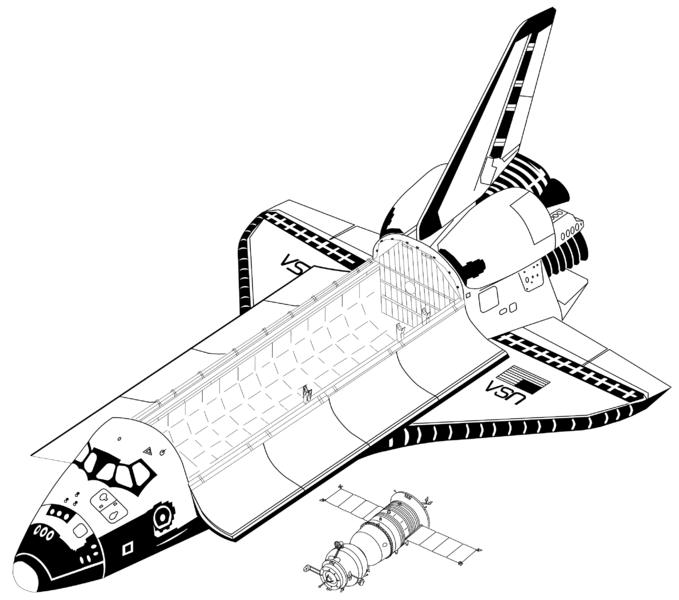[/caption]
Here’s an interesting illustration showing the size comparison of a Space Shuttle to a Soyuz vehicle, shared on Twitter by NASA astronaut Rick Mastracchio (@AstroRM). Amazing to think that three flight-suited astronauts are able to fit inside a Soyuz and have life support for up to a month! (Although I’m sure most hope they won’t have to stay that long.)
Compare the 7-person capacity, 65.8 cubic meter crew cabin of an orbiter to the 3-person, 10 cubic meter space inside a Soyuz and one can imagine how cozy it must get during trips to and from the Station.
Rick is currently in training for a Soyuz flight to the ISS in November of next year as a member of the Expedition 38 crew, at which time he’ll get plenty of first-hand experience with the precise interior measurements of a Soyuz.
Thanks to Rick for sharing this! You can find out more about the Soyuz vehicles here, and check out the full source publication MIR Hardware Heritage (1995) by David S. F. Portree for Johnson Space Center.


A month in a Soyuz capsul!!! Can you imagine the diaper rash?!
R.I.P. US Manned Space Program, *sigh*
R.I.P? (sigh) How did we ever survive the ‘gap’ (and it is only that, not he end of US space flight, space program, or however else it’s been described) between all previous US manned spacecraft?
Also, I don’t think any Soyuz mission actually exceeded 18 days, a record until Salyut-1. (And at least you can move to the orbital compartment of a Soyuz for a while…14 days in pretty much a seated position on Gemini-7, *that* had to be a bear, even in microgravity)
They had a plan between each space program in the past. The current space program doesn’t have a direction, just like the current administration (and sadly most Americans) doesn’t have a clue.
Yes, NASA DOES have a direction: back to earth! I think that the long term “plan” is to serve as a kind of kindergartner for current and future commercial space ventures.
This illustration is from my book MIR HARDWARE HERITAGE, published by NASA in March 1995. Another illustration shows that the Soyuz launch vehicle is about the size of one Shuttle SRB.
Soyuz habitable volume is a little over 10 cubic meters, not seven.
Soyuz is used as a space station ferry, so doesn’t really need to have a lot of room in it. In addition to the capsule, there is an Orbital Module at the front of the spacecraft to provide extra room during the two-day trip to the station.
Also, Shuttle carried as many as seven people with no Spacelab or Spacehab in its payload bay. Those flights lasted between five and 10 days. The room available per crew member (~9 cu m) was greater than Soyuz (~3.3 cu m), but not enormously different, as the post implies, and actually less if one factors in time spent on board.
Soyuz is not designed to support a crew for a month. The longest anyone stayed aloft on board a Soyuz was back in 1970, when two cosmonauts lived on board for 18 days. They had a fair bit more room than the Gemini 7 crew, who stayed aloft for 14 days.
If you don’t like the end of Shuttle flights, you should have protested when Bush cancelled the program back in January 2004, then protested again (and again) when Bush repeatedly failed to request adequate funding to complete its replacement. Bitching about the state of U.S. human spaceflight now is pretty lame – where were you when it would have made a difference?
Thanks for the info David. I did see a note elsewhere saying that the Soyuz had 30 day life support capabilities; could that have been for a later version?
They said 10 cubic meters. Funding was there for the next program, the current administration cooked the books to help out Space X (a generous contributer to the Obama campain). And to answer your question, I was working for the space program to help make it better. One thing that I’ve seen is, everybody claims to make it cheaper and faster. We’ve seen how well that works. I don’t forsee the next vehicle doing any better, no matter who launches it.
That’s the problem with our Walmart society… cheaper and faster doesn’t always mean better. Actually it rarely does, IMO.
Early in the shuttle program after the first ‘proof of concept’ test flights, our military flew several tippy top secret shuttle missions. I have often wondered after what happened during those flights… One scenario has it that the shuttle rendezvoused with Soviet spacecraft and captured them with the robot arm and put them into the shuttle bay – then actually brought those spacecraft back to Earth for forensic exam? One wonders, yet will probably never know…